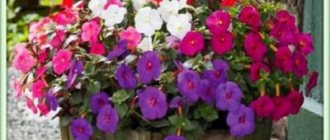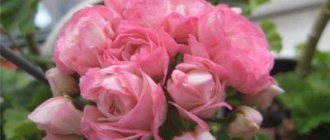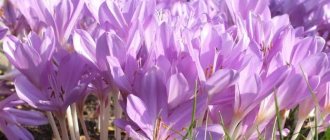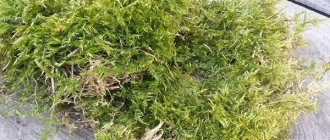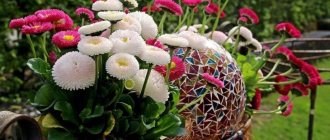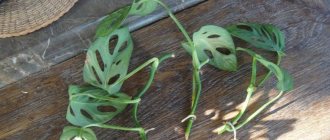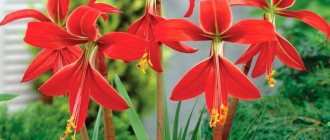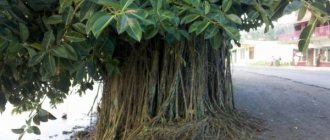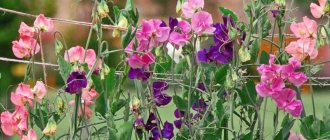Growing
Peculiarities:
- the flower is grown in spacious pots, but not in open ground;
- pelargoniums do not tolerate bad weather - gusty winds, rain, cold and fog are destructive for them;
- flowers love the sun, but you shouldn’t leave them in the heat under the scorching rays;
- in winter, most varieties are dormant, they lose their decorative effect, stretch out and stop blooming;
- It is not advisable to place plants near heating radiators in winter;
- from the beginning of the growing season, the bushes need to be shaped by proper pruning of the shoots;
- faded roses need to be removed - then the whole bunch will continue to bloom;
- Rosebud pelargoniums are fertilized with phosphorus-potassium fertilizers.
In order for a plant to please the grower with its flowering, it is necessary to choose the right soil for it. The soil should be loose, nutritious, and have neutral acidity. We must not forget about good drainage - 1/3 of the pot is filled with expanded clay.
It is recommended to use the following composition:
- agroperlite – 1/10 part;
- sand – 1/10 part;
- humus – 2/10 parts;
- peat – 2/10 parts;
- turf soil - 4/10 parts.
For rosebud pelargoniums, southern and southwestern windows are best suited. If this is not possible, then you need to provide the plants with special phytolamps. In very hot weather, when the air temperature reaches +30 degrees, the sun can burn the leaves of plants. On the street it is better to move them to partial shade, and in the house to protect them from the rays with curtains.
Temperature
In summer, the optimal temperature for this plant is considered to be from +20 to +25 degrees. In winter it should be at least +15 degrees.
In its homeland in Africa, this plant species lives in arid soils rich in limestone, calcium and chalk, so the plants tolerate drought well and suffer from waterlogging. Plants should not be watered too much. This should only be done when the top layer of soil is completely dry. In winter, watering is reduced.
Plants do not like spraying, like all varieties with pubescent leaves. Pelargoniums need to be watered carefully so as not to soak the roses. The water must be soft, standing for at least 24 hours.
Features of flowering
This flower is more familiar to ordinary people under the name ivy-leaved geranium. The peculiarities of caring for this plant are largely determined by the phases of development of this plant at different periods of time. During periods of rest and activity, conditions of detention and rules of care have certain features.
Rest period
Pelargonium refers to plants in which the dormant period is not particularly pronounced. It slows down its growth and does not bloom, but does not go into a completely dormant state. This period falls in winter.
In winter, stop applying fertilizers and reduce watering to a minimum. It is also advisable to move the flower to a more shaded place.
Activity period
The spring-summer period is a time of active growth for pelargonium. This is also the time of peak flowering. Sometimes you can see flowering in winter, but this is rather an exception to the rule.
During the active phase, the plant requires a lot of strength. For this reason, pelargonium is regularly fed with fertilizers and watered abundantly before the onset of cold weather.
Types and shape of flowers
Flowers can vary greatly in flower shape and color. Color can vary from bright pink to deep scarlet. Varieties with snow-white flowers, for example White Split, are very attractive.
The shape of the flowers can be:
- simple - the petals are arranged in one row;
- semi-double - have 2-3 rows of petals on flowers;
- terry - the petals are densely arranged in several rows.
Attention! Many types and varieties of pelargonium allow each gardener to choose a plant with a favorite shade of flowers and a preferred shape
Reproduction
Pelargonium is propagated by seeds (they are sown in December - February) or cuttings. Flower growers usually prefer the second method.
In spring or summer, cuttings are cut (length 5 - 7 cm, 3 - 5 internodes, 4 leaves). Inflorescences and leaves are removed from below.
Tip! Immerse the shoots in a damp mixture (soil, sand, perlite). It is better to use transparent plastic cups for these purposes. Do not cover with a bag or jar. After 2 - 3 weeks, the cuttings take root. They are transplanted into pots.
Another very beautiful variety of geranium is Pelargonium Millfield Gem. The culture is also from the Ivy-hybrid group. Its flowers are double. Pelargonium Millfield Jam differs from Millfield Rose in flower colors. They are creamy white, have pink-caramel shades, and raspberry inclusions.
Growing Millfied Rose pelargonium is not that difficult. It is enough to strictly follow all the recommendations and she will thank you with beautiful flowering.
Caring for Fischers Appleblossom pelargoniums
Geranium hybrid plants are popular because they have very beautiful flowering, bright shades of leaves, and compact bushes. But so that they do not lose their qualities, they need constant care. These plants will stretch their stems if they grow in an area with insufficient light. It is necessary to monitor the shape of the crown of plants: in spring and autumn, shape the bush, cut and thin out old and deformed branches, shorten shoots, remove dried flower stalks and leaves.
During flowering, pelargoniums need regular watering with settled, rain or spring water at room temperature. Every two weeks in spring and summer, solutions of complex fertilizers are applied to the root zone of flowering plants after the main waterings.
Important! Without fertilizing, plants will stop growing and will not be able to form flower buds. In spring, summer until mid-autumn, pelargoniums actively bloom
From mid-October to the end of February, plants should be placed in cool rooms so that they stop their development and can take a break from active processes. During this period, do not feed the flowers; water them when the soil in the flower pots is 1/3 dry
Pelargoniums bloom actively in spring, summer and mid-autumn. From mid-October to the end of February, plants should be placed in cool rooms so that they stop their development and can take a break from active processes. During this period, the flowers are not fed; they are watered when the soil in the flower pots is 1/3 dry.
For your information! To prevent plants from getting sick and suffering from pests, biological products designed to combat rot, viruses, and insect larvae are used for preventive purposes. These can be fungicides foundationazol, ridomil gold, phytosporin-M, insecticides actara, fas, calypso.
Zonal variegated pelargonium
Reproduction of hybrid plants cannot be carried out using seeds; many novice flower growers greatly regret this, because not everyone is immediately able to root a cutting of geranium or pelargonium. But it’s worth learning so that you can admire such beautiful flowers as Fischers Appleblossom pelargoniums.
Growing problems, diseases and pests
When growing geraniums there is a risk of rot or viral infection. It may also suffer from pest attacks.
How to deal with them
To prevent the occurrence of diseases, you need to use fungicides - Fitosporin, Fundazol. To prevent insect attacks, insecticides are used - Calypso or Aktaru.
As diseases develop, the leaves become spotted
Pelargonium Fischers Appleblossom is very popular among gardeners. In order for the bush to bloom and develop luxuriantly, it requires full care. It should include the correct watering regime, pruning, and fertilizing.
Technical data of the plant
In Russia, indoor hybrids Fischers appleblossom pelargonium are popular, descriptions of which can be found in catalogs of companies selling plants. For this type of flower, the directory provides the following characteristics:
- The bush branches well. The seedling takes root 10-12 days after planting;
- leaves are round and green. They are bordered by a dark stripe;
- The hybrid's caps are quite tight. Large flowers are shaped like a rose. Their color can be white or reddish. Flowering lasts 4-6 months;
- the dimensions of Fischer pelargonium in the indoor version do not exceed 0.7-0.75 m in height. If it grows in a greenhouse, the height of the bush can reach 2 m.
Note! It is better not to leave geraniums in a room where the air temperature is below 14-15 °C. Under such conditions, the hybrid may get sick and die.
The plant has medicinal properties. It emits an extract that can relieve respiratory tract damage. This African subshrub is used to make an oil that calms the nervous system.
Some information about the hybrid
Pelargonium Fischer appleblossom is grown in open areas and summer cottages in the southern regions of Russia. In the middle zone and northern regions, people grow the plant on windowsills using a clay pot. Pelargonium has gained popularity due to its ease of care and growth rate.
The name of the African bush comes from the fruits that look like a crane's beak. Under suitable conditions, geranium (the Russian name for the plant) can bloom all year round, but for most species the growing season occurs in the summer.
Pelargonium Fischers Appleblossom
Description
Apple Blossom translated into Russian means “apple blossom”. Thanks to skillful breeders, to the delight of lovers of these flowers, not only pink pelargoniums have appeared in the world, reminiscent of the picturesque blooms of spring gardens, but also many other varieties of stunning beauty.
Pelargonium Fischers Appleblossom. This is a magnificent rosebud rosaceous pelargonium variety. Pale pink inflorescences with peach or red edging are collected in lush clusters on elastic short peduncles. Blooms profusely from May to August.
"Fisher" branches well, has dense large stems, and is quite compact. It propagates vegetatively, by lateral shoots with five leaves. Loves light and warmth.
Ungarisk Appleblossom. Zonal rosaceous pelargonium with bright red velvety petals with a lilac edge and a white underside. The inflorescences are distinguished by their splendor and density, are endowed with a high peduncle, and look elegant and solemn. The bush is large, powerful, branched, has emerald foliage with pronounced zones.
“Ungarik” is a high-maintenance variety that requires warmth, good lighting and bush shaping. To see the first flowering, you need to be patient: the plant may not bloom in the first year of life.
Rosebud Westdale Appleblossom. This is a rosebud pelargonium, which has unusually colored leaves with a green central zone and large, light milky edging around the edges. The flowering of the plant is no less amazing: the flowers are white, double. They look like half-open roses with a soft pink or red border.
The plant blooms very luxuriantly all season with magnificent large caps. The bush itself is tall, powerful, and looks decorative.
Westdale loves partial shade, diffused light and warmth. The plant is demanding when it comes to watering: it cannot tolerate dry air and soil, and does not tolerate waterlogging or drafts. It's hard to please him. As a sign of its dissatisfaction, the “capricious” always strives to shed its leaves.
Knight Appleblossom F1. This is a zonal, very unpretentious, beautiful hybrid variety that blooms all year round in the house, and in the warm season (from May to September) - outside. The flowers of the plant are pink-carmine, with a light pink center. The magnificent, unusually colored foliage is cherry-brown with a bright green edge.
"Night" is a large, branched and lush bush. The plant loves light, but can bloom beautifully in shaded areas and is drought tolerant. Loves good and regular watering. It feels great not only on southern, but also on western or eastern windows.
Happy Appleblossom. This pelargonium is the pride of any gardener. Against the background of leaves with a central zone in the shape of a light green butterfly, huge white and pink caps of inflorescences of delicate roses rise on tall slender peduncles.
The bush requires care, loves the sun, regular but moderate watering. It is necessary to form the crown of the plant, otherwise the shoots stretch out and look like straight sticks and do not branch. Cuttings cut while trimming a bush take root well.
Exotica Appleblossom. Not small, but very compact bush, with dense, soft pink double roses. The variety is distinguished by the fact that it blooms elegantly and for a long time. In bright summer light, the petals may take on a creamy or salmon color. Bright light greenery is in great harmony with the lovely voluminous pink inflorescences.
Apple Blossom Rosebud. An ancient variety that every collector in love with rosebud pelargoniums has. With its sophistication and beauty, Apple Blossom Rosebud won the heart of Queen Elizabeth of England. Graceful roses, collected in an inflorescence-bouquet, have a white center with a light green tint and creamy petals that smoothly turn into a rich pink hue. The bush is strong, with fleshy thick stems and delicate, light green foliage.
This noble plant does not require special attention; it feels great outdoors and at home.
Regular haircuts, timely watering and warmth are all you need for gorgeous and long flowering.
Where and how to plant?
This plant will require much more attention than ordinary “balls”. Let's consider what needs to be provided for good growth and flowering.
Lighting and location
This plant is considered light-loving, but it should not be allowed to be exposed to direct rays of the sun. Because of this, the stems and leaves begin to wither, turn yellow, and there is not enough water for normal growth.
For this reason, you should choose a place with good lighting, but darken it with special window material or fabric. This way the geranium will have a sufficient amount of light, but there will be no burns that spoil the health and appearance of the beauty. In addition, strong sun causes the plant to bloom less.
Such pelargoniums grow not only indoors, but also in the garden or on the balcony. If you comply with all conditions of detention
It is important to note that all varieties of this variety are sensitive to prolonged low temperatures. It is better if the flowers are not exposed to temperatures less than +10
Soil requirements
Soil for rosebud geranium can be purchased at a special store or prepared with your own hands. You should purchase land with an acidity of 5.6-6.5.
Self-preparation will require a combination of turf soil (4 parts), coarse sand (1 part), peat (2 parts), perlite (1 part) and humus (2 parts). In such soil the plant feels great.
The planting pot should be slightly larger than the root system. If it is too free, flowering will not occur, but if it is too tight, the plant will wither.
Pelargonium "Appleblossom" - what kind of flower is it, what family does it belong to?
Apple Blossom translates to “apple blossom.” Thanks to the achievements of breeders, it was possible to obtain not only pink flowers, but also other varieties of geraniums. This crop belongs to the Geraniaceae family.
The culture is characterized by beautiful decorative inflorescences
Pelargonium Appleblossom Rosebud was developed by the German company Pelargonium-Fischer. She has approximately 1,200 types of flowers.
Plants of this variety of culture are perennials with branched stems, long peduncles and palmate leaves. Even at home, fruit pods with seeds are formed on the crop.
The plant requires sufficient light. It should be placed on a south or southwest window. If this is not possible, use special lighting.
In summer, the optimal temperature is 20... 25 degrees. With the arrival of cold weather, this figure should be at least 15 degrees.
Important! Pelargonium should be watered carefully to avoid moisture getting on the flowers. To do this you need to use soft, settled water.
The culture needs to be moistened on time
To feed the plant, you can use ready-made formulations. Mineral products or preparations for flowering crops are suitable. However, it is best to use specialized formulations that are suitable for geraniums.
A pot that is not too large is suitable for the flower. As the bush develops, it can be moved to a larger container.
Pruning and replanting
The first time geraniums need to be pruned after flowering has finished. In this case, only half the height of the shoots is left. At the end of February you need to prune the bush again, leaving the stems with 3-4 nodes.
Note! Every year, geraniums are transplanted into looser containers. It should not be too large, otherwise the bush will not bloom normally
Appleblossom flowers
The history of Appleblossom pelargoniums begins in 1870, when in France, by crossing zonal and garden plants, rose-like flowers with petals collected in double inflorescences were obtained. They became famous due to the fact that they were used to create bouquets and as boutonnieres. The noble coloring of the inflorescences with all sorts of shades of pink has become a distinctive feature when describing pelargoniums by Appleblossom rosebud.
Pink iridescence of Appleblossom petals
Plants of the pelargonium species Appleblossom Rosebud are perennials with branching herbaceous stems, palmate leaves and long flower stalks, at the ends of which multi-flowered umbrellas of inflorescences are formed. Even in indoor conditions, after artificial pollination, flowers can transform into fruit pods with seeds.
For your information! Reproduction of hybrid flowers is carried out by dividing bushes and cuttings.
Rules for growing pelargonium Appleblossom Rosebud
Apple Blossom Rosebud needs conditions typical for zonal pelargoniums, that is, good lighting and warm conditions, a nutritious, but at the same time loose, permeable substrate.
Thus, growing pelargonium Apple Blossom Rosebud comes down to several points:
- Lighting. It is preferable to have well-lit window sills that are exposed to the sun for several hours a day. On the south side, it is advisable to shade the pots so that the leaves do not suffer from burns; it is better not to grow them on northern windows;
- Watering. It is necessary to moisten the soil constantly, as the top layer of the substrate dries, but always in moderation. The earthen lump should neither dry out nor become waterlogged;
- Trimming. To obtain a compact bush with a harmonious crown, pelargonium must be pruned. Strong shortening of shoots is carried out at the end of February, sanitary pruning is carried out as necessary. Pinching the apical and lateral cuttings is also required;
- Feeding. During the period of bud formation and flowering, Appleblossom Rosebud must be fed using fertilizers for Geraniums or compositions for flowering indoor plants.
Like other zonal pelargoniums, Apple Blossom Rosebud loves fresh air and ventilation, but reacts negatively to drafts. For this reason, with the onset of warm weather, the bush is taken out to the balcony, veranda or loggia, creating flower arrangements and always returning it to the apartment before the cold weather.
The optimal temperature for growing and flowering Apple Blossom Rosebud is between +17-+23 degrees. When the temperature drops below +12, the plant stops developing and often dies from hypothermia of the root system.
The Apple Blossom Rosebud variety will decorate your windowsill, delighting you with lush flowering if grown correctly.
Features of cultivation
Caring for pelargonium Apple Blossom Rosebud is not difficult, since the flower is unpretentious. It does not need to be watered often; it grows well on the sunny side of the windowsill. Without light, the leaves turn white and fall off, the stem becomes longer, and flowers do not form.
Important! For this species you need to choose a small pot.
This is due to the fact that the roots are not very branched, so they cannot absorb the entire volume, the soil begins to sour, which will lead to the death of the plant. It is necessary to ensure that the soil is well permeable to air and moisture. Therefore, you should make a soil mixture from:
- fine expanded clay;
- coconut fiber;
- fertilizers in granules.
Varieties of rosebud pelargoniums
Variety Exotica Appleblossom Rosebund
A variety of rosaceous umbrella pelargonium.
It is characterized by fairly compact bushes, blooms in large, dense inflorescences, and does not fade for a long time. The shape of the flowers resembles roses. The flowers have a soft creamy color with a slight soft pink blush.
Variety Horizon Star
Refers to zonal pelargoniums.
The bush is compact. A hybrid with large simple flowers, the diameter of which is about 4 centimeters. White-pink, with a red-coral eye in the center, a flower with a coral-colored border along the edge of the petals, reminiscent of a phlox flower.
Blooms early and abundantly. The bush is decorated with umbrellas of large inflorescences. The foliage is colored bright green.
Variety PAC Viva Rosita
Gained popularity among flower growers.
The plant is a compact bush, produces many shoots, lasts a long time and blooms profusely. The inflorescence contains up to 20 double flowers. The diameter of one flower is up to 6 centimeters, which are colored red-crimson.
Learn more about pelargoniums by watching the video:
I think this spring the pelargonium happy appleblossom rosebud will be planted at our dacha. A strong-willed decision was made precisely after reading this material. And this is correct, since it is written clearly and efficiently.
Planting seeds
This event looks like this:
- first of all, the seeds must be soaked for 2 hours before sowing;
- then you need to distribute them in the prepared greenhouse at a distance of at least 2 cm from each other;
- after this, you need to cover the crops with a small layer of loose, moist soil;
- The last stage is spraying the soil with a spray bottle.
The greenhouse is kept at a temperature of no more than +25 degrees and must be ventilated. The first shoots will appear in 5-7 days.
The shoots are rooted in water. The process looks like this step by step:
- you need to take an opaque container;
- then prepare a solution for seedlings: take “Kornevin” powder on the tip of a knife for 100 g of water;
- the plants are kept in the preparation for a day;
- Pelargoniums are placed in a glass with settled water and two tablets of activated carbon until roots form.
Rooting in the ground. This process consists of the following manipulations:
- when pruning the plant (in February-March), you need to select strong, healthy tops and lateral cuttings with 2-3 internodes;
- then you should prepare separate cups with drainage holes;
- after this you need to fill the container with wet peat or sand;
- it is necessary to plant the cuttings in the recesses, dipping the tip of the stem in “Kornevin”;
- the appearance of fresh leaves indicates successful rooting.
You can learn more about planting pelargonium in the following video.
Pelargonium Lady Gertrude - what kind of flower is it, what family does it belong to?
The culture was bred by European breeders. They were faced with the task of making the plant bloom in summer and autumn. At the same time, scientists tried to obtain a new type of pelargonium of small height with unusual flowering. It took them 25 years to do this.
The flower has beautiful pale pink inflorescences
For selection, ivy-leaved and hybrid varieties of geranium were used. As a result, we managed to obtain geranium of the Lady Gertrude variety. It is rarely found on sale, but is often grown by experienced gardeners.
Brief description, history of origin or selection
Pelargonium Lady Gertrude is a hybrid that has many features. The plant has an underground rhizome, on which thick and thin fragments alternate. The culture is characterized by a small number of peduncles, which are gradually covered with large pink petals. As they bloom, they take on the shape of a rose.
Lady Gertrude has large decorative leaves. At the same time, the bush itself is compact in size. It tends to grow in width, but at the same time it is quite dense. Due to this, pelargonium is given any shape.
Additional Information! The key feature of this pelargonium is the late onset of flowering. This variety is considered one of the most attractive. At the same time, it is easy to grow.
A distinctive feature of the variety is the late onset of flowering.
'Apple Blossom Rosebud'
'Apple Blossom Rosebud'
Post by Passific » 13 Dec 2010, 20:10
Pelargonium 'Apple Blossom Rosebud' Rosaceous zonal pelargonium. The flowers are white, double, with a deep pink border, collected in rosettes. Green Leaves .1948
Apple Blossom Rosebud
Post by Pepino » Dec 24, 2010 12:13 pm
Marina, I have information that this variety was bred back in the 19th century, around 1870
Re: Apple Blossom Rosebud
Post by Passific » Dec 24, 2010 12:54 pm
Re: Apple Blossom Rosebud
Post by Pepino » Dec 24, 2010, 01:03 pm
Re: Apple Blossom Rosebud
Post by AEA » 24 Dec 2010, 14:11
Re: Apple Blossom Rosebud
Post by Svetlana55 » 09 Jan 2011, 19:36
Apple Blossom Rosebud
Post by Selena32 » Jan 17, 2011, 08:03
Here's mine. I have about 60 varieties, but this one has settled forever
The leaves in the first photo are not hers
Re: Apple Blossom Rosebud
Post by UTA » Jan 17, 2011, 2:12 p.m.
And this variety is also Queen Elizabeth’s favorite.
Re: Apple Blossom Rosebud
Post by Bella » Mar 04, 2011, 08:51 pm
Re: Apple Blossom Rosebud
Post by Svyatoslav » 04 Mar 2011, 20:54
Re: Apple Blossom Rosebud
Post by Mila M » May 19, 2011, 10:52 pm
I love this variety!
Re: Apple Blossom Rosebud
Post by Pepino » May 19, 2011, 11:10 pm
Re: Apple Blossom Rosebud
Post by Passific » May 19, 2011, 11:21 pm
Re: Apple Blossom Rosebud
Post by Mila M » Jun 20, 2011, 10:58 pm
Re: Apple Blossom Rosebud
Post by zvet*lana » June 30, 2011, 4:31 pm
Re: Apple Blossom Rosebud
Post by Svyatoslav » June 30, 2011, 6:04 pm
Re: Apple Blossom Rosebud
Post by Milanashka » Sep 18, 2011, 00:48
Re: Apple Blossom Rosebud
Post by Vasilisa » 10 Oct 2011, 08:12
I have two varieties from Hommer, Apple Blossom Rosebud and Happy Appleblossom Rosebud, so only Happy Appleblossom Rosebud has a lighter center of the leaves, Apple Blossom Rosebud is just green and the flowers are different, although they grew together all the time
Growing in open ground
Soil and lighting requirements:
The area should be well lit
It is important that the sun's rays are not too active and the plant does not get burned. To do this, you can create a small artificial shadow during the hot period.
The composition of the soil must be light, loose, not dense, the clay content is minimal, soil that is too dense will not provide sufficient air supply to the roots.
Methods
- Pelargonium should be planted outdoors using seedlings or transplanting an adult plant from a pot into the ground.
- Outdoor planting is possible only with the onset of stable heat, without possible frosts.
- An abundance of sunlight heals the plant, makes its color brighter, the bush stronger, and the flowers more saturated.
- In open ground conditions, natural hardening of the plant occurs.
- Cuttings outside take root faster and easier than in a pot.
Landing rules
If you need to plant an adult bush that has wintered indoors outside, this requires certain rules:
If the plant grows too much, it needs to be pruned.
It is important to comply with the deadlines, do this in February or early March. The trimmed bush should be placed on the sunniest side. It is necessary to carry out a series of fertilizing. It is necessary to increase watering of the plant, preferably through a tray. After the onset of stable heat, the plant is transplanted into open ground by transferring an earthen clod from a pot into the ground. The plant requires watering as the soil under the bush dries out
It is easier for a flower to tolerate aridity than excess moisture. Too much watering leads to the development of fungal diseases and rotting of the root system. It is better to water the plant earlier in the day.
The plant requires watering as the soil under the bush dries out. It is easier for a flower to tolerate aridity than excess moisture. Too much watering leads to the development of fungal diseases and rotting of the root system. It is better to water the plant earlier in the day.
Feeding
Rosebuds bloom for a long time and profusely, for this they require a lot of effort. An excellent help for the flower would be to apply mineral fertilizers once a month during the entire flowering period. The plant does not require nitrogen fertilizers. When fertilized with nitrogenous fertilizers, the bush and green foliage will grow, which will prevent flowering. It is better to leave the introduction of nitrogenous substances into the soil until the fall, after the flower has been transferred from the garden to the house.
Reference! It is much easier not to plant the plant in the ground, but to move the bush from the house to the garden in a pot, leaving it there for the entire summer period. With the onset of cold weather, you need to bring the pot into the house. In unstable weather, with a lot of rain and cool temperatures, the option of taking the plant out in a pot for a day is optimal.
Subtleties of fertilizing
Pelargoniums are often mistakenly fed too much.
Applying the usual feeding scheme for summer plants - weekly procedures - to the plant is not the best idea. This plant requires standard feeding, and an excess of both macro- and microelements affects its development. If you feed indoor “geranium” outside the phase of active vegetation and flowering, or apply too intense or frequent feedings, you will achieve nothing but rapid growth, deformation and problems with stability.
It is no coincidence that the choice of fertilizers reduces all options to mixtures in which potassium and phosphorus dominate. Even the same percentage of nitrogen in fertilizers leads to the growth of lush greenery, which means its excess. Feeding with incorrectly selected mixtures often leads to a delay and lack of flowering in home geraniums.
Ideally, the percentage of nitrogen should not exceed 11%
When choosing fertilizers, pay attention to the proportion of phosphorus, which is critical for this crop, as well as the presence of trace elements iodine in it
Pelargoniums are often mistakenly fed too much. Presseportal
Other varieties of PAC Viva
Pelargonium PAK Viva Carolina has “sisters” - varieties of geraniums with similar general characteristics and unique coloring of inflorescences:
- PAC Viva Madeleine. It has a pleasant creamy hue, the flowers are pink and white in one plexus. Against this background, the red core of the stamens stands out.
- PAC Viva Rosita. This is a scarlet-red geranium with delicate flowers burning in the sun, reminiscent of a cross between a peony and a rose.
- PAC Viva Maria is a delicate flower, similar in color to orchids: the edges of the petals are soft pink or white, and the bases are crimson.
There is also a variety called Princess Caroline. These are exotic buds in coral and watermelon tones with variegated, dotted petals. Typically, Princess Caroline pelargonium is a soft pink flower with bright splashes, but in special conditions the opposite can happen.
Geranium Viva Carolina is associated with wedding bouquets
The “sisters” look good together, complementing each other with their outfits. Such a bouquet will definitely bring lightness and solemnity to the greenhouse.
Propagation by cuttings
Rosebud can be propagated by seeds, but this is problematic. The best option is cuttings. Suitable period for this:
- mid-spring;
- The end of the summer;
- beginning of autumn.
That is, the time when the rosebud is not in “hibernation” and does not bloom. Another condition is not to overfeed. If you plan to take cuttings, do not overfeed the plant. Soil preparation should be taken seriously, as it determines whether the plant will take root. The composition should include:
- peat;
- river sand;
- Earth.
In this case, the soil should be moderately moist. The cutting should be:
- strong;
- healthy;
- sluggish (to avoid rotting);
- the length must be more than 5 cm.
Water along the edge of the glass. Water temperature – about +20 degrees
It is important not to overwater a young plant! The optimal air temperature should also be about +20 degrees. If young leaves appear, this is a sign that the plant has taken root.
If you are cutting a plant in early spring, be sure to use additional lighting. Fluorescent lamps are suitable for this.
- https://stroy-podskazka.ru/pelargoniya/sorta/appleblossom/
- https://dacha.expert/domashnie-rasteniya/tsvetushhie/pelargoniya/vidy-p/rozebudnye.html
- https://7ogorod.ru/cvety/apple-blossom-rosebud-pelargonia.html
- https://rastenia.info/tsvetyi/geran/pelargoniya-apple-blossom-rosebud.html
Varieties of indoor plants with names and what they look like
There are many varieties of culture known. Each variety has a unique botanical description.
Caroline
Characterized by delicate, densely double flowers of lilac-white color. The bushes are decorated with dark green leaves. 3-5 buds appear on each peduncle. The plant has long and lush flowering.
Madeleine
The plants are decorated with wide but small leaves of a dark green hue. The flower belongs to the double zonal species of pelargonium. The inflorescences are white with a pink tint, which appears in the sun.
Rosita
The plant is characterized by bright pink terry buds. Has green leaves. 5-6 buds appear on each peduncle. During the flowering period, which lasts 2 weeks, the bushes are decorated with bright and lush flowers.
The Rosita variety has bright pink inflorescences
What it is?
Rosebud geranium is a spectacular representative of double hybrids with graceful flowers collected in lush inflorescences, reminiscent of small bush roses. The color of the buds varies:
- white;
- pink;
- blue;
- red.
The flower is quite unpretentious, the main thing is to provide it with proper care:
- water and fertilize the plant in a timely manner;
- maintain the required temperature and humidity in the room.
South Africa is considered the birthplace of rosebud geranium. Back in the 18th century, the flower was brought to Europe, and in the 19th it was isolated as a separate species. The origin of rosebud geranium occurred through crossing with other species of the same crop.
Advantages and disadvantages of the variety
We invite you to read the descriptions of particularly popular varieties, as well as look at photos of plants whose flowers resemble roses.
Belongs to the zonal miniature type. Has beautiful double flowers. At first, the flowers bloom white, but as they mature, they acquire a pink tint. In one head of inflorescence, there can be two colors at once - white and pink, which gives special sophistication and beauty. The inflorescences are small in size, but densely planted. Blooms profusely during the summer season.
Supreme
The Rosebud Supreme plant differs from other species in its very late onset of flowering, but upon entering the flowering season, it blooms a huge number of inflorescences, each of which looks like a ball strewn with small rose buds of a beautiful red color. The bush of the plant is powerful, strong, tall.
The Appleblossom rosebud plant grows very quickly and, without careful and frequent formative pruning, grows into a long, powerful bush. The plant blooms luxuriantly. The inflorescences are distinguished by their original colors. In the middle there are green-white petals, then the color changes to white, and the edges are soft pink.
Vectis
The bush of this species is compact, easy to shape, and the flowering is long and abundant. With the beginning of spring, inflorescences form, turning into flowers of rich red color. The outer side of the petal is much lighter than the inner. The plant blooms for a long time, maintaining its unique shape throughout the entire flowering period.
Pink (Pink Rambler)
This variety of zonal pelargonium is the most famous. The bush is unpretentious in care, has a powerful structure and lush, abundant flowering. The flowers are bright, pink-carmine in color, the foliage is rich, corrugated. The underside of the petal is lighter. Pink begins to form inflorescences a little later than pink-flowered zonal plants, but compensates for this with continuous flowering throughout the season.
